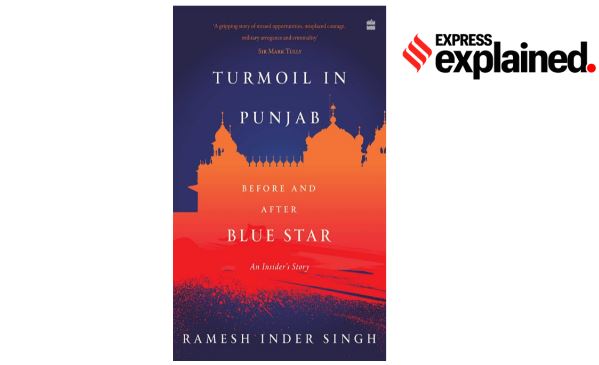Explained Books: 38 years later, an insider’s account of Operation Blue Star
Ramesh Inder Singh’s ‘Turmoil in Punjab: Before and After Op Blue Star’ is an insider’s account of the events that precipitated Blue Star and also its aftermath that led to the killing of a Prime Minister, a Chief Minister and thousands of innocents.
Thirty-eight years after Operation Blue Star, here is an account by a Punjab bureaucrat who saw first-hand the state’s steep descent into violence, and then its arduous climb back to peace. Ramesh Inder Singh, who retired as Chief Secretary of Punjab, was Deputy Commissioner of Amritsar when troops stormed the Golden Temple to flush out militants in June 1984.
Singh’s Turmoil in Punjab: Before and After Op Blue Star is an insider’s account of the events that precipitated Blue Star and also its aftermath that led to the killing of a Prime Minister, a Chief Minister and thousands of innocents. Divided into two parts, it also takes a brief look at the seeds of the tumult.
It is rich in anecdotes — recounting how, for instance, Singh as an SDM first met the fiery preacher Jarnail Singh Bhindranwale through Simranjit Singh Mann, then an IPS officer posted at Faridkot — and sweeping, covering politics, religion, and the foreign hand (an euphemism for the ISI) that brought Punjab to the brink.
Blue Star was kept such a top secret that even the IB director did not know about it. The Cabinet sub-committee on political affairs met in May 1984 in which Finance Minister Pranab Mukherjee opposed Army action but was overruled by Prime Minister Indira Gandhi. She maintained contact with Bhindranwale through R L Bhatia (an MP from Amritsar) who was in touch with latter’s confidant Bhai Amrik Singh, R I Singh writes. The book deconstructs the making of Bhindranwale into a demagogue by Congress that was seeking a counter to the Akalis.
Singh argues that militancy in the state, which started with the Akali-Nirankari clash in 1978, was never a Khalistan movement. Even Bhindranwale, when prodded, would say, “I am not asking for it but I will not oppose it if the government gives it.”
A survey by a Delhi professor in 1985 found only 6% of the state’s population had any sympathy for Khalistan. Khalistan was first formally demanded in 1986 by a five-member panthic committee whose members included Gurbachan Singh Manochahal, anointed Akal Takht Jathedar in the presence of Parkash Singh Badal and Capt Amarinder Singh, who were then in one camp.
The book underlines how Pakistan diverted funds from the US to fight Russians in Afghanistan to foment trouble in Punjab. It claims Pakistan was also part of the end of militancy; Pakistan PM Benazir Bhutto gave information about militants to PM Rajiv Gandhi in exchange for withdrawal of forces from Siachen. Later, she accused Rajiv of not keeping his commitment.
Singh says one reason why the violence exploded into an ethno-national struggle was “lack of good governance, poor law enforcement and an indifferent criminal justice administration”. These are issues as real today as 40 years ago. “History has an uncanny habit of repeating itself, and we have to be on guard.” Singh hopes the book, which is critical of all sides, will lead to dialogue and reconciliation.


